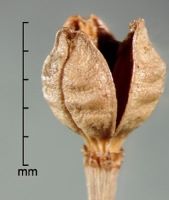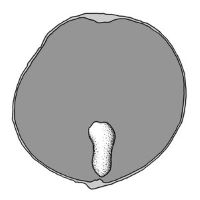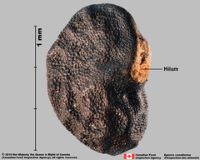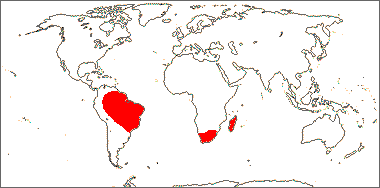Family name: Strelitziaceae (K. Schumann) J. Huchinson
Synonym(s): [none]
Common name(s): bird-of-paradise-flower family
*Number of genera/species: 3/7
List of genera records in GRIN-Global
fruit or seed
Fruit a loculicidalloculicidal:
type of capsular dehiscence, opening longitudinally through the locules (compare septicidal)
 capsulecapsule:
capsulecapsule:
a dry, dehiscent fruit derived from a compound ovary , 11–70 mm long, oblongoblong:
, 11–70 mm long, oblongoblong:
2D shape—much longer than broad with nearly parallel sides, corners are rounded or trigonoustrigonous:
or trigonoustrigonous:
3D shape—having three faces that meet at distinct angles; triangular in outline
, angledangular:
2D shape—having sides that meet at acute or obtuse angles
in transection, beakedbeak:
a usually firm, terminal appendage, sometimes tapered (sometimes short or dehiscentdehiscent:
(sometimes short or dehiscentdehiscent:
(v. dehisce) splitting open at maturity to release contents (of a fruit) ), with many seeds. Pericarppericarp:
), with many seeds. Pericarppericarp:
fruit wall or fruit coat
brown, woodywoody:
texture—consisting mainly of indurate lignified tissues, characteristic of or resembling wood
.
Seeds globoseglobose:
3D shape—more or less spherical , tereteterete:
, tereteterete:
approximately circular in cross section; width and thickness approximately equal
 or flattened in transection, with rudimentaryrudimentary:
or flattened in transection, with rudimentaryrudimentary:
(of embryo) embryo is small and fills less than a quarter of the seed and can be variable in shapes, such as linear, spatulate, or oval or well developed (Ravenela) opercula without micropylar collarsmicropylar collar:
or well developed (Ravenela) opercula without micropylar collarsmicropylar collar:
collar shaped tissue at micropyle
. Seed coat brown or black, shinyshiny:
uniformly reflecting a high proportion of incident light at all angles , with blue (Ravenela), orange (Strelitzia), or red (Phenakospermum) dense hairlike arilaril:
, with blue (Ravenela), orange (Strelitzia), or red (Phenakospermum) dense hairlike arilaril:
(broad sense) appendicular structure that wholly or partly envelops a seed and is produced from or a modification of the funicle, raphe, or outer integument; usually fleshy or pulpy, sometimes spongy or tufted-capillate, often brightly colored , hard, smooth or striatestriate:
, hard, smooth or striatestriate:
surface relief—having fine, parallel lines, grooves or ridges . Arilaril:
. Arilaril:
(broad sense) appendicular structure that wholly or partly envelops a seed and is produced from or a modification of the funicle, raphe, or outer integument; usually fleshy or pulpy, sometimes spongy or tufted-capillate, often brightly colored well-developed, adnate to hilumhilum:
well-developed, adnate to hilumhilum:
on seeds, the scar indicating where the funiculus was attached; on grass caryopses, the scar visible on the outer fruit surface revealing where the seed is attached on the inner fruit wall surface; or in Asteraceae cypselae, the scar visible on the outer fruit wall revealing where the fruit was attached to the receptacle or seed coat, and fleshy.
or seed coat, and fleshy.
Embryo large, capitatecapitate:
head-shaped; abruptly enlarged on one end to a relatively short, terminal portion
, straight or curvedcurved:
(of embryo) linear embryo is curved into an arch or horseshoe with the ends far apart .
.
Endosperm copious, mealymealy:
loose, dry, and disintegrating in finely granular
pieces like meal or flour
.
| Fruit | |
| Type | capsulecapsule: a dry, dehiscent fruit derived from a compound ovary  |
| Size range | 11–70 mm long |
| Shape(s) | oblongoblong: 2D shape—much longer than broad with nearly parallel sides, corners are rounded  , trigonoustrigonous: , trigonoustrigonous:3D shape—having three faces that meet at distinct angles; triangular in outline |
| Texture | woodywoody: texture—consisting mainly of indurate lignified tissues, characteristic of or resembling wood |
| Color(s) | brown |
| Unique features | Brown, woodywoody: texture—consisting mainly of indurate lignified tissues, characteristic of or resembling wood , beakedbeak: a usually firm, terminal appendage, sometimes tapered  capsules with globoseglobose: capsules with globoseglobose:3D shape—more or less spherical  arillate seeds. arillate seeds. |
| Seed | |
| Shape(s) | globoseglobose: 3D shape—more or less spherical  |
| Surface relief | smooth, striatestriate: surface relief—having fine, parallel lines, grooves or ridges  |
| Color(s) | brown, black |
| Unique features | Brown or black, globoseglobose: 3D shape—more or less spherical  , smooth or striatestriate: , smooth or striatestriate:surface relief—having fine, parallel lines, grooves or ridges  seeds with brightly colored, dense hair-like coverings or lacinate lobes of arilsaril: seeds with brightly colored, dense hair-like coverings or lacinate lobes of arilsaril:(broad sense) appendicular structure that wholly or partly envelops a seed and is produced from or a modification of the funicle, raphe, or outer integument; usually fleshy or pulpy, sometimes spongy or tufted-capillate, often brightly colored  . . |
| Other | |
| Embryo | large, capitatecapitate: head-shaped; abruptly enlarged on one end to a relatively short, terminal portion , straight or curvedcurved: (of embryo) linear embryo is curved into an arch or horseshoe with the ends far apart  |
| Nutritive tissue | endosperm copious, mealymealy: loose, dry, and disintegrating in finely granular pieces like meal or flour |
Tropical South America, southern Africa, and Madagascar.

Distribution map courtesy of Angiosperm Phylogeny Website.
Baskin and Baskin 2021Baskin and Baskin 2021:
Baskin C and Baskin J. 2021. Relationship of the lateral embryo (in grasses) to other monocot embryos: A status up-grade. Seed Science Research 31 (3): 199-210. doi:10.1017/S0960258521000209; Dahlgren et al. 1985Dahlgren et al. 1985:
Dahlgren RMT, Clifford HT, and Yeo PF. 1985. The families of the monocotyledons: structure, evolution, and taxonomy. Springer-Verlag, Berlin. 520 pp.; Kirkbride et al. 2006Kirkbride et al. 2006:
Kirkbride JH, Jr, Gunn CR, and Dallwitz MJ. 2006. Family guide for fruits and seeds, vers. 1.0. Accessed September 2020-January 2022. URL: https://nt.ars-grin.gov/seedsfruits/keys/frsdfam/index.cfm .; Kubitzki et al. 1990+Kubitzki et al. 1990+:
Kubitzki K et al., eds. 1990+. The families and genera of vascular plants. 7+ vols. Berlin etc.; Stevenson and Loconte 1995Stevenson and Loconte 1995:
Stevenson DW and Loconte H. 1995. A cladistic analysis of monocot families. In: Rudall PJ, Cribb PJ, Cutler DF, and Humphries CJ, eds. Monocotyledons: Systematics and Evolution. Royal Botanic Gardens, Kew.
*The number of genera and species is based on Christenhusz and Byng 2016Christenhusz and Byng 2016:
Christenhusz MJM and Byng JW. 2016. The number of known plant species in the world and its annual increase. Phytotaxa 261 (3): 201-217. https://doi.org/10.11646/phytotaxa.261.3.1, which may differ from the number of genera in GRIN-Global.